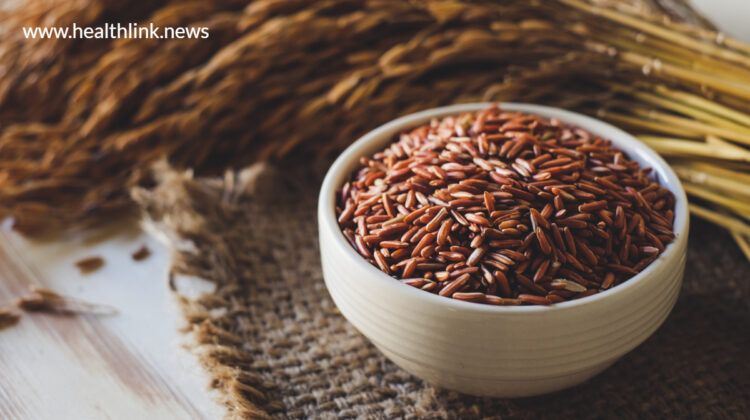Brown Rice: Good for Weight Loss and Heart Health

All types of grains are excellent sources of complex carbohydrates and some important vitamins and minerals, but whole grains (the healthiest grains) in particular are an important part of a healthy diet. Some kinds of whole grains include Barley, Buckwheat, Bulgur (cracked wheat), Millet, Oatmeal, and Brown rice.
Today, rice is the staple food of more than 100 cultures and more than 40,000 varieties are cultivated. Many of these varieties can be manufactured and sold as brown rice. Brown rice means eating rice as a whole grain. This is important because the less grain you process, the more nutrients you get. The two outer layers of brown rice, the bran, and germ contain most of the vitamins and minerals in the grain. These layers are removed when the manufacturer makes white rice, which is why brown rice is a healthier choice.
Brown rice is a nutritious high-fiber food associated with a healthy diet. The layer of bran that is normally stripped from white rice is preserved in the brown one. This means that brown rice contains valuable phytochemicals such as essential amino acids, fiber, vitamins, flavonoids, and phytic acid, an anti-nutrient that exhibits antioxidant function and possesses medicinal value. The primary source of all these nutrients comes from carbohydrates, so people on low-carb diets avoid eating brown rice.
Some people also doubt the nutritional value of brown rice, because they think it is just a food rich in carbohydrates. That’s not true. Rich in vitamins, proteins, and fiber, this whole grain is an excellent source of slow-release energy that helps maintain optimal body function throughout the day. Being a high-carb food, brown rice is low in fat, low in sugar, and rich in protein. Brown rice is an important part of a healthy diet that may reduce the risk of chronic illness.
Nutrition
Brown rice comes in several varieties, including long, medium, and short-grain. But, whichever one you choose, know that it is beneficial for your health.
For one cup serving of brown rice, you receive:
Calories: 216
Carbs: 44 grams
Fiber: 3.5 grams
Fat: 1.8 grams
Protein: 5 grams
Thiamin (B1): 12% of the RDI
Niacin (B3): 15% of the RDI
Pyridoxine (B6): 14% of the RDI
Pantothenic acid (B5): 6% of the RDI
Iron: 5% of the RDI
Magnesium: 21% of the RDI
Phosphorus: 16% of the RDI
Zinc: 8% of the RDI
Copper: 10% of the RDI
Manganese: 88% of the RDI
Selenium: 27% of the RDI
This whole grain is also an excellent source of folate, riboflavin (B2), potassium, and calcium.
In addition, brown rice is very rich in manganese. This lesser-known mineral is essential for many important processes in the body, including bone development, wound healing, muscle contraction metabolism, nerve function, and blood sugar level control.
Manganese deficiency is associated with an increased risk of developing metabolic syndrome, bone demineralization, impaired growth, and low fertility. Only a cup of rice covers almost all daily needs of this important nutrient.
Brown rice is not only an excellent source of vitamins and minerals but also a powerful phytochemicals. For example, brown rice contains phenols and flavonoids, which are antioxidants that protect the body from oxidative stress.
Oxidative stress is associated with many health problems, including heart disease, certain types of cancer, and premature aging. The antioxidants in brown rice help prevent cell damage by unstable molecules called free radicals and reduce inflammation in the body. Studies show that antioxidants in rice may be the reason for the low prevalence of certain chronic diseases in regions of the world where rice is the staple food.
Health Benefits of Brown rice:
Brown Rice is a popular gluten-free whole grain option for people diagnosed with celiac disease, wheat sensitivity, or non-celiac gluten sensitivity. With the number of phytochemicals, it contains, it has been shown to play a valuable role in disease prevention. Many of the health benefits of brown rice come from the antioxidants, fibers, and other valuable compounds found in the bran layer. Brown rice is associated with a variety of medicinal properties, including:
1. Helps to reduce the risk of diabetes
Brown rice has a low glycemic index (GI), so even if you eat it, your blood sugar level will not rise sharply. Eating three servings of whole grains daily, such as brown rice, can reduce your risk of developing type 2 diabetes. White rice, on the other hand, can increase the risk of diabetes. People who eat a lot of white rice are more likely to develop diabetes than people who eat less.
2. Improves heart health
Many of the nutrients in brown rice help keep your heart healthy. Rich in fiber can reduce the risk of death from heart disease. Brown rice is also rich in magnesium and helps reduce the chance of heart disease and stroke.
3. Good for Weight loss
Adding brown rice as a dietary staple may also assist those who are obese to shed extra weight and decrease their body mass index, a common marker of healthy or unhealthy weight. Eating brown rice instead of white may also significantly reduce weight, body mass index (BMI), and circumference of the waist and hips. Brown rice additionally carries extra nutritional fiber than white rice. Higher-fiber ingredients purpose you to experience fuller longer at the same time as taking in fewer calories. If you update white rice with brown rice, you’ll be capable of consuming much less without feeling hungrier.
A study of over 74,000 women found that those who ate more whole grains weighed consistently less than those who ate fewer whole grains also, the women who had the highest intake of fiber had a 49% lower risk of major weight gain than the women who had the lowest fiber intake.
In one study, 40 overweight women who ate 2/3 cup (150 grams) of brown rice per day for six weeks had significant reductions in body weight and waist circumference compared to women who ate the same amount of white rice. Additionally, the women who ate brown rice experienced a significant decrease in blood pressure and CRP, a marker of inflammation in the body.
Brown Rice – Naturally Gluten Free
Gluten is a protein found in grains such as wheat, barley, and rye. Today, more and more people are eating gluten-free for a variety of reasons. Certain people are allergic or intolerant to gluten and experience mild to severe reactions such as abdominal pain, diarrhea, gas, and vomiting. In addition, people with certain autoimmune diseases often benefit from a gluten-free diet. These factors are driving the demand for gluten-free foods.
Fortunately, brown rice does not naturally contain this problematic protein, making it a safe choice for those who cannot or do not want to take gluten. Unlike highly processed gluten-free products, brown rice is a whole grain packed with beneficial nutrients that the body needs to function properly. Brown rice is also another healthy gluten-free product that people with gluten-free diets can enjoy, such as crackers and pasta.
Varieties
As we know brown rice comes in different varieties. It also takes longer to cook than refined white rice.
Short brown rice has a short, plump, and rounded appearance. Grains are tender, and they tend to stick together when cooked.
Medium-grain brown rice is larger and plump than short-grain rice, but not as large as long-grain rice. Grains are very moist, tender, and less sticky when cooked than short-grain varieties.
Long grain brown rice is longer and thinner than medium and short-grain varieties. It is also the most well-known variety and is used in popular dishes such as rice pilaf. Grains are light, fluffy, and separate when cooked.
To cook your brown rice:
- Rinse your rice in cool water to remove extra starch and any dust that might have built up.
- Add the rice to a pot with about 1 ½ cups of water for every cup of dry brown rice.
- Bring the water to a boil.
- Reduce the heat to low and cover the pot.
- Let the rice simmer for about 20 minutes before you take it off the heat.
- Leave the rice to sit and steam for another 10 minutes before you serve.
You can also use the rice cooker to heat the rice until it’s cooked and automatically switch to heating mode.
- Use the same proportions of rinse, dried brown rice and water.
- When the rice cooker is finished, leave it in the heat insulation mode for 5 to 10 minutes so that the rice is not sticky.
Brown rice is a staple food for healthy side dishes and various recipes. There are several ways to try it.
- Add to healthy carb soup. Fry vegetables and meat or tofu and add brown rice.
- Mix the rice with beans, salsa, vegetables, and possibly chicken.
- Combine with minced beef and spices to make bell pepper stuffing.
- Make rice pudding with milk, sugar and eggs.
